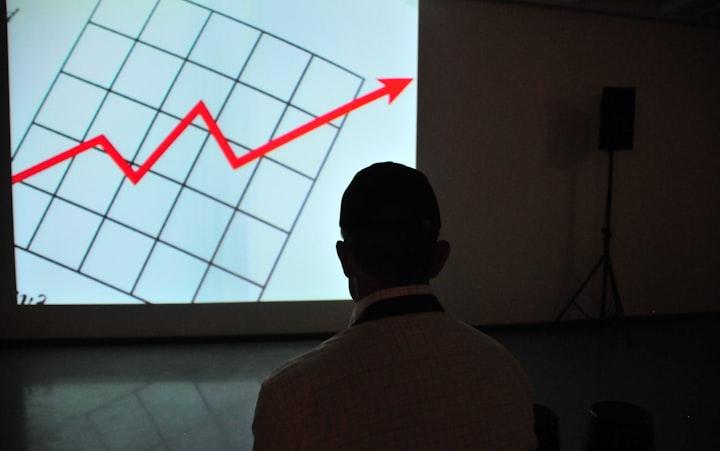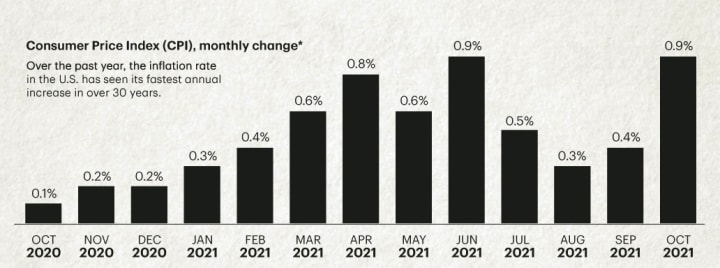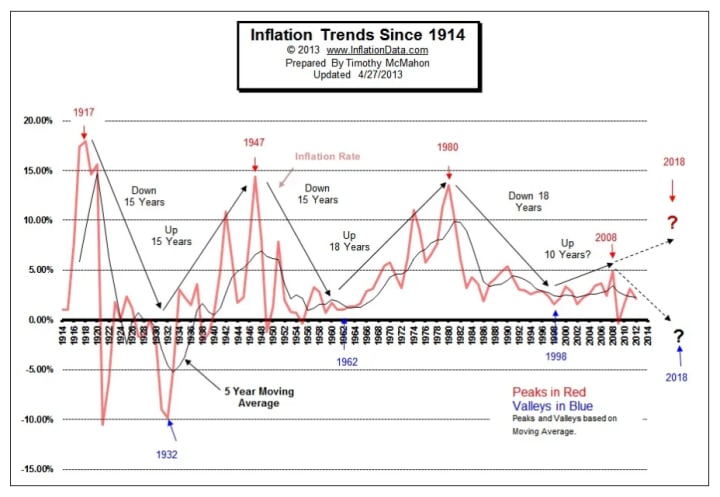Inflation is Everywhere, But Should We Be Surprised?
Today’s headlines remind us all that prices are going up, up, up! This analysis shows us how our present inflation looks historically and how management, and all of us, should be planning for the future.

Overview
Inflation. You can't turn on the TV without hearing about it. You can’t go to the grocery store without seeing it. You can’t have a conversation with family, friends, or colleagues without the subject coming up. Today, there seems to be no bigger story or pressing concern - well, except for that pesky COVID virus that just won’t seem to go away - than inflation. Seemingly everywhere we turn today, from buying food for our families...
from looking at cars (both new and used)...
from buying furniture for our homes…
(and home prices as well)...
from traveling anywhere - by any means...
or from driving through the line of our favorite fast food place...
we see prices going up, up, up!

And no, your eyes - and wallet - are not deceiving you! Prices are going up, and that means that inflation is indeed on the rise. And as inflation is rising, that makes all of our lives just that much more difficult as our paychecks don’t go quite as far as they did just last month!
And as businesses grapple with not just inflation, but with supply chain issues and a growing difficulty in finding and retaining workers, management across the board, from the smallest of firms to the largest, are facing one of the most challenging and turbulent operating environments in modern business history!
In this article, we will look at the current economic environment, one where inflation is very, very real! However, we also look at putting today’s inflation numbers in context historically, both in the short and long terms, and what a realistic view of what we are all experiencing today means for us - both individually and collectively moving forward.
Inflation Today
As the saying goes, the numbers simply don’t lie. We are seeing rising inflation today across the board. One of the best recaps on just what is happening - along with why inflation is happening across many sectors of the economy - was recently released by the data analyst firm, Visual Capitalist. Their report, entitled "The U.S. Inflation Rate Has Seen Its Fastest Annual Increase in Over 30 Years. Which Consumer Spending Categories Have Been Hit the Hardest?," provides a great overview of the inflationary pressures that we are seeing across the economy today (and I highly recommend that you seek it out for a detailed discussion of today's inflationary pressures across many sectors of the economy).
As you can see in Figure 1 (Monthly Increases in the Consumer Price Index (CPI), October 2020-October 2021) below, the Consumer Price Index (CPI), the generally accepted measure for measuring inflation, has been on the
Figure 1: Monthly Increases in the Consumer Price Index (CPI), October 2020-October 2021

Source: Visual Capitalist, The U.S. Inflation Rate Has Seen Its Fastest Annual Increase in Over 30 Years. Which Consumer Spending Categories Have Been Hit the Hardest?, November 2021 (Used with permission).
rise over the past 12 months. While the Federal Reserve has targeted annual inflation to be at 2% over the long-term, in order to promote “maximum employment and price stability,” we have seen inflation overall rise at a rate far above that over the past year. Indeed, across a wide variety of categories of goods and services, Americans have experienced not just a double-digit rise in prices, but inflation in those areas of the economy causing prices to rise by 20, 30, 40, even 50% year-over-year (See Figure 2: Inflation in Specific Categories of Goods and Services, October 2020-October 2021).
Figure 2: Inflation in Specific Categories of Goods and Services, October 2020-October 2021

Source: Visual Capitalist, The U.S. Inflation Rate Has Seen Its Fastest Annual Increase in Over 30 Years. Which Consumer Spending Categories Have Been Hit the Hardest?, November 2021 (Used with permission).
With these levels of price increases across not just a few spending categories, but almost across the board, consumers can see and feel inflation as being a very real force as they go about living their daily lives. That is why inflation has become the topic of the day today - across kitchen tables, in the media, and in the halls of power in Washington!

Today’s Inflation in Historical Terms
Yet, the inflation we are seeing today is, at least in part, a statistical anomaly coming out of the COVID-19 pandemic. 2020 was a tumultuous year, and demand for many products and services plummeted across the board. As such, in 2021, with the recovery from the lows of the pandemic economy well underway and pent up demand for many goods and services being unleashed as the country and the world return to “normal” - for the most part, inflation has naturally resulted as the economy bounces back from the effects of the coronavirus. The annual inflatn rate is now officially at 6.2%. And as you can see in Figure 3 (Inflation in the United States, 2019-2021), the three year moving average inflation rate is now 3%, putting us well above the 2% threshold set by the Fed. Thus, today’s inflation concerns are very real - for government policymakers, for companies, and for us as consumers.
Figure 3: Inflation in the United States, 2019-2021

Source: Statista, Inflation Hits 31-Year High - How Bad Is It Really?, November 2021 (Used with permission).
Yet, the inflation we are experiencing today - while very real and very concerning - is still low by historical standards for the U.S. As can be seen in Figure 4 (Average Inflation Rates by Decade in the U.S. Over the Past Century) below, we have a long way to go to approach the high - and sustained - inflation of the 1970’s and 1980’s. While the average inflation for the 2020’s may indeed end up being higher than that of the preceding two decades of the 21st century, we would have to see today’s inflation continue for some time to approach anything like that of the worst decades in modern American history.
Figure 4: Average Inflation Rates by Decade in the U.S. Over the Past Century

Source: InflationData.com, Average Annual Inflation Rates by Decade, January 2021, (Used with permission)
And if one does look at economic history, today’s inflation - while certainly being accelerated by the pandemic and the ramifications of it throughout global supply chains and labor markets - could well have been anticipated. As one can see in Figure 5 (Historical Inflation Rates and Trends in the United States) below, over the past century, we have seen rounds of higher inflation every 15-18 years in the United States. And so from a historical perspective, today’s inflation actually should have come sooner in time than what has actually occurred in the pandemic period of 2020 and 2021.
Figure 5: Historical Inflation Rates and Trends in the United States

Source: InflationData.com, Inflation Trends Since 1914, April 2013 (Used with permission)
Analysis
Now there may indeed be some “good news” about inflation, as some economists do believe that the current rise in prices may indeed be peaking…
… which would be great news for everyone and for every business. But as with any economic issue, there are conflicting opinions on inflation, with some economists saying that it will be a force with us for some time.
However, one thing we can say with absolute certainty about us Americans. We have a very, very short-term focus - on everything! We focus on today, in every area of concern - in business, sports, politics, money, etc. And so it should come as no surprise that when it comes to inflation, we have a collective memory lapse as to the realities of inflation historically - and in our ability to put today’s “pain in the pocketbook” into a larger context. And this is especially true for younger Americans, as those under 40 today really have no adult memories of having seen and experienced inflation in any real way. Their knowledge of the inflation of the 1970’s and early 1980’s comes from the history books, and as we all know, most of the time, teachers in high school and professors in college charged with teaching the modern history of America never get much past Word War II - or the Sixties at best!
And even so, economic issues are often treated as sidebar concerns in history lectures and textbooks, even though they may have everything to do with developments on the political and even military fronts, both at home in the U.S. and abroad. And while we’re beating up on American education’s shortcomings about economics, there is scant attention paid to just how well we have had it in the U.S. historically when it comes to inflation compared to the hyperinflation that has occurred even in recent times even in advanced economies in Europe, Africa, Asia, and South America.
So in the end, we are all faced with tough choices to make regarding inflation, both in our personal and business lives. In managing both our family’s finances and our company’s operations, we have to make what are, when you strip things down to their very essences, educated guesses as to what will happen price wise over the next few months and even years ahead. Whether to lock in contracts at today’s prices or gamble that they will go up - or even down - over the next weeks, months, years can indeed be high stakes decisions at both levels.
From my perspective, as a strategic management consultant and professor, I do believe that today’s inflation numbers are exacerbated by the pandemic. After all, we have not - in all the annals of modern business history - ever basically shutdown much of our economy and then restarted it (and then had to do so again in many regions of the world due to the Delta variant). And so I think that much of the uncertainty and fear that is baked into pricing across the board today will wane as we - hopefully - do get the COVID-19 pandemic much more under control, even if the risks from the virus are not eliminated. As we transition from where COVID is a pandemic to it being endemic, all of us can make far more rational decisions - on everything. And thus, I do sincerely believe that we will see inflation cool - not disappear entirely, but not be the “number one with a bullet” concern that it is for everyone today - as we head into 2022 and beyond. Of course, as with an economic prognostication, there is the alternative scenario, and so the wise word would be to stay alert to the inflationary pressures we are experiencing today, as if the pandemic does not come under control and/or if there are additional economic/political/social/epidemiological shocks to the system, we could see price pressures grow even more intense. Stay tuned...
++++++++++++++++++++++++++++++++++++++++++++++++++++
About David Wyld
David Wyld is a Professor of Strategic Management at Southeastern Louisiana University in Hammond, Louisiana. He is a management consultant, researcher/writer, publisher, executive educator, and experienced expert witness. You can view all of his work at https://authory.com/DavidWyld.
Social Media Links to David Wyld:
About the Creator
David Wyld
Professor, Consultant, Doer. Founder/Publisher of The IDEA Publishing (http://www.theideapublishing.com/) & Modern Business Press (http://www.modernbusinesspress.com)






Comments
There are no comments for this story
Be the first to respond and start the conversation.